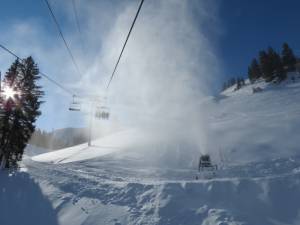Martinsville, NJ – Despite a strong start to the 2011-12 ski season, with autumn snow allowing for earlier-than-usual openings at some resorts, the subsequent months have been less favorable for resorts and enthusiasts alike. However, Condor Capital’s Ken Schapiro discusses why there is reason for optimism heading into the second half of the season.
Although a welcomed respite for many municipalities that had their budgets strained by snow removal efforts last year, anemic snowfall totals and unseasonably warm temperatures in recent months have put a damper on the first half of the 2011-12 ski season. To illustrate the extremes being witnessed, Vail Mountain in Colorado received just 19 inches of snow through Christmas Day versus its longer-term average of 33 inches. This resulted in the latest opening for the mountain’s much-vaunted Back Bowls in the resort’s history and a 15.3% year-over-year decline in skier days through the first fiscal quarter. This same story has played out at many resorts across the United States, with those in the Northeast being impacted particularly hard.

However, despite the sharp decline in skier days, Vail Resorts reported that overall ticket and ski school revenues were up 0.60% and 0.90%, respectively, over last year. Furthermore, KBW Capital Markets estimates that spending per skier is up 10%, indicating that the ski industry continues to track similarly to the luxury end of the retail market, where sales continue to outperform low- to mid-tier stores. From a lodging perspective, bookings for the second part of the season remain solid, with on-the-books reservations for the January to June period tracking 6.7% above last year. It is important to note, though, that these figures may not directly translate into actual occupancy. To illustrate, December occupancy increased 1.3%, while prior figures indicated that bookings for the month rose a much-stronger 11.3%.
As for retail, data from the SnowSports Industry of America (SIA) show that winter sports retail sales increased 10% during the early part of the season, between August and September, building off the momentum generated in the prior season. However, it is likely that this strength has tapered off somewhat as ski equipment and apparel purchases tend to be heavily influenced by the prevailing weather and snow conditions. To that end, figures from Leisure Trends indicate that outdoor sales declined by 2% in December along with snow sports hard and soft goods, and big box retailer Dick’s Sporting Goods reduced its earnings guidance for the fourth quarter due to the unseasonably warm temperatures across the country.
While poor conditions have plagued most of the U.S., there have been some bright spots for skiers in other parts of the world. Resorts such as Red Mountain and Whistler Blackcomb in British Columbia, Canada, where snow has been plentiful, are fully open. Across the Continental Divide in Alberta, ski resorts surrounding Banff and Lake Louise have snowfall to date roughly 150 percent of normal. Across the pond, portions of the Alps in France, Austria, and Switzerland have also benefited from large storms that have dumped feet of snow. Although high winds and avalanche risks have somewhat dampened the positive effect of these totals, it should support a strong finish to the season as the weather becomes milder and the snow pack settles.
Looking towards the second half of the season, however, there are reasons for hope in the U.S. The past few weeks have been much more favorable for western resorts, with snowfall beginning to pick up in the Rockies and large storms dumping many feet of snow in the Pacific Northwest. However, blocking high pressure has returned, forcing storms to split around the region once again. the direction of a meteorological index known as the Arctic Oscillation (AO) is likely to be the key to good conditions for the remainder of the season. In general, a negative AO results in an increased push of cold Arctic air into the lower-48 states, while a positive figure is associated with warmer temperatures across the northern U.S. After being decisively negative last year, the index has been strongly positive so far this season, hitting its second-highest level since 1950. Some meteorologists predict that this trend may reverse in the coming weeks, but forecasts in this area are difficult to make and the degree to which it may reverse is disputed.
If mountain conditions do improve, resorts may be able to regain their footing on the backs of increased consumer confidence, a decline in the national unemployment rate, and special deals aimed at spurring business. For instance, Crested Butte in Colorado is offering a package including airfare, a four-night stay, and a three-day lift ticket for just $599, while Big Sky in Montana is offering free lift tickets to holders of Vail Resorts’s Epic Pass when they book lodging at the mountain. Red Mountain offered free lift tickets to all U.S. residents through Feb. 6 to combat the poor perception of the season due to the lack of snow in most areas of the U.S. Overall, special deals, combined with a downward trend in the Travel Price Index, may encourage destination skiers to book vacations for the second half of the year.
Still, even if snow trends do recover dramatically, overall skier days are likely to decline from last year as the weak start to the season has likely dampened skiers’ overall enthusiasm and may cause many to write off the year. As a result, total skier days are likely to fall by mid-single digits, says Schapiro, a New Jersey-based investment advisor who focuses on the ski industry. While resorts’ revenues are also likely to decline overall, those such as Vail that derive a hefty share of their sales from prepaid season passes may be able to buck the trend.

